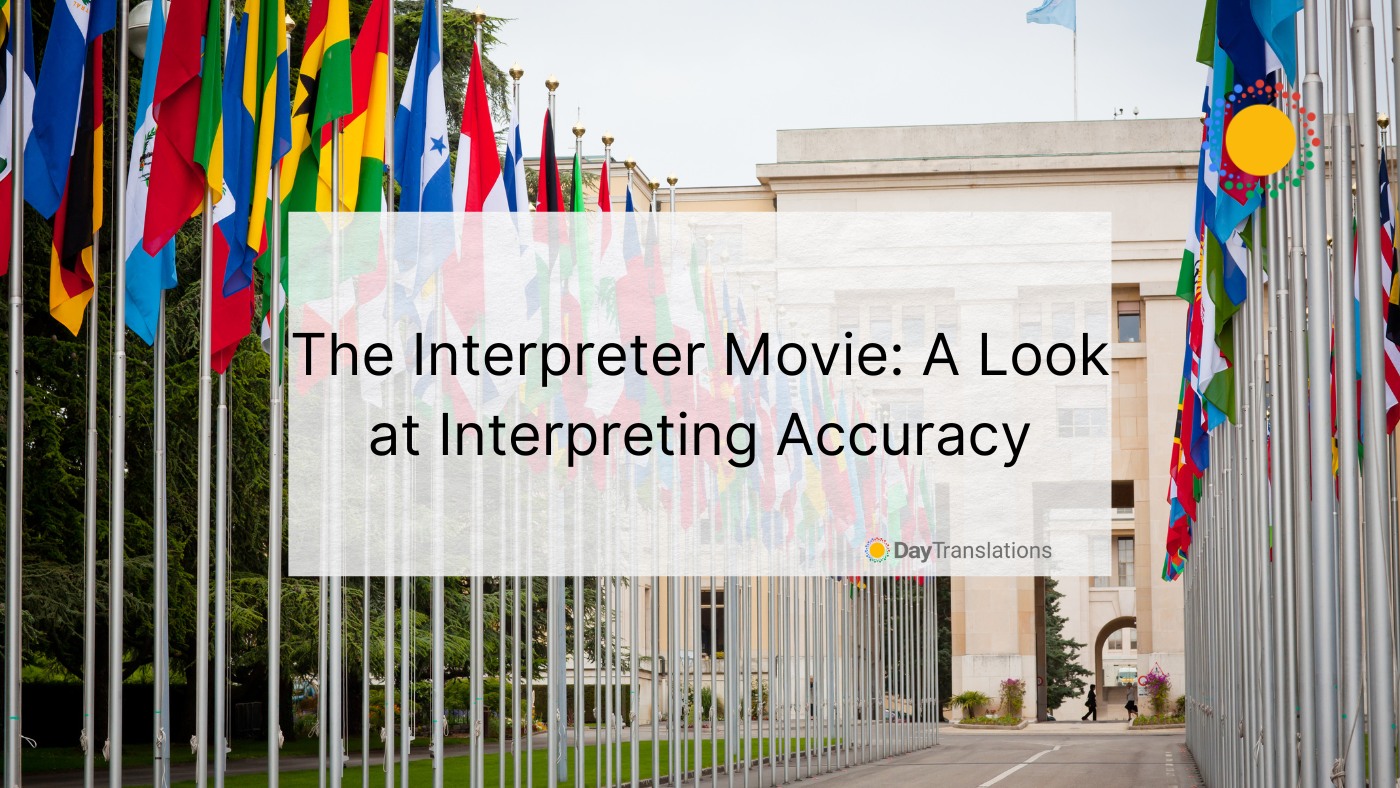Updated 2022
The Interpreter movie, a political thriller starred by Nicole Kidman and Sean Penn, is one of the few movies with an interpreter as the main character. Even more noteworthy is the fact that it was the first film to shoot scenes within the United Nations Headquarters. If you are fond of languages and politics, The Interpreter can be an enjoyable movie to watch.
However, is it an accurate depiction of interpreting or the life of an interpreter? How realistic are the scenes? Find out the answers to these questions and more below.
The Interpreter Movie – The Plot
The Interpreter is the story of Silvia Broome (Nicole Kidman) who is described by the UN Security Chief in the movie Lee Wu (Clyde Kusatsu) as the United Nations herself. This is due to Broome’s diverse background. She has a British mother and a white African father, but she was born in the United States. This makes her a dual citizen of the United States and the country of origin of her father, Matobo. Broome spent most of her years in Matobo but she moved to Johannesburg to study music, then she went to Paris and other European countries to learn linguistics.
Matobo in the movie is perceived to be a representation for Zimbabwe. The producers decided to avoid using a real African country as the other major setting of the story (aside from New York) to avoid issues that may be raised on account of the delicate subjects tackled by the film. However, the minor locations used in the movie refer to real places such as Johannesburg and Paris.
Broome’s Work
Broome works as an interpreter for the United Nations. One night, she had to return to her office to take some of her things when she overheard two men talking in the fictional language Ku (the lingua franca of Matobo in the movie). Broome happens to be fluent in Ku, so she understood that the men were discussing an assassination plot. Broome initially ignored or somewhat forgot what she heard, but while doing some interpreting work the next day, she recognized some words and phrases that appeared related to the assassination plot conversation she overheard. She reported this to the United Nations security and it was discovered that the target of the assassination was President Edmond Zuwanie (Earl Cameron), the head of state of Matobo.
Zuwanie was set to be indicted at the International Criminal Court for charges of ethnic cleansing and other atrocities in Matobo. He rose to power as a liberator, but over the past two decades, he turned into a corrupt president and ruled tyrannically just like the government he helped overthrow. Seeking to avoid indictment, he was scheduled to go to the UN Headquarters to present his side to the General Assembly.
The US Secret Service appropriated agents from the Dignitary Protection Division to protect the Matoban president and investigate the plot against him. Two of the agents were Tobin Keller (Sean Penn) and Dot Woods (Catherine Keener). They were tasked to secure Zuwanie and his personal head of security, Nils Lud (Jesper Christensen), who happens to be a Dutch mercenary.
A Twist in the Tale
Things turned complicated when Keller learned that Broome had some involvement with a guerilla group in Matoba. Her parents and sister died because of landmines installed by Zuwanie’s henchmen, and she was once romantically involved with one of the political adversaries of Zuwanie. This discovery made Keller suspect Broome. However, they eventually grew closer that Keller ended up protecting Broome.
Meanwhile, Broome received a call from one of the Matoban guerillas she was associated with. The caller informed her of the death of one of their friends but couldn’t ascertain what happened to her brother, which Broome tried to find out. Her efforts led her to a number of instances of almost getting killed. Zuwanie’s men were after her life.
In the later part of the movie, Zuwanie was in the middle of addressing the General Assembly when his purported assassin was discovered and killed. Broome anticipated this and planned on killing the criminal Matoban leader herself. Keller later found out that the assassination attempt against Zuwanie was a false flag operation to solicit sympathy and support the claim that his opponents were terrorists. Broome was about to kill Zuwanie when Keller appeared to stop her. Zuwanie was eventually indicted and Broome and Keller reconciled.
Interpreting Scenes: Are They Realistic?
Source: https://www.youtube.com/watch?v=FwE6qDq6rFE
For the benefit of those who have not seen this 2005 movie, the plot summary above has been written to be Wikipedia-like or somewhat comprehensive. However, to more adequately address the main topic of this article, presented below is a summary of the movie’s major interpreting scenes or scenes wherein the actors were talking about interpreting.
Obviously, since The Interpreter is not some educational or infotainment film production, you can’t expect it to focus on what an interpreter does. The drama, action, and thriller elements prevail.
Scene 1: United Nations assembly scene
Here, the camera pans across a UN session and catches Silvia Broome doing simultaneous interpreting in a remote sound booth. She interprets Ku into English.
This depiction is realistic and accurate. The UN has several glass booths for pairs of interpreters to work together for a session. Two interpreters alternately do the interpreting. Usually, if one is interpreting, the other provides assistance like looking for data or finding the right words to use for a specific line.
The United Nations does not have an interpreter for every language of all member nations. Instead, it uses six official languages, namely English, French, Arabic, Spanish, Russian, and Chinese. Speakers in a plenary session must use any of these languages. If they can’t or they don’t want to, they have to bring their own interpreter, who must then translate the speaker’s speech into any of the six official languages. The interpreters in the remote sound booth then interpret from the interpretation of the interpreter used by the speaker.
A “relay system” of interpreting is used to efficiently facilitate understanding among plenary session attendees. This means that a speaker’s speech is interpreted into the six official languages of the UN, then more interpreters translate from the interpretations in the six official languages into their target (typically less popular) languages.
Scene 2: Private meeting in the UN building
This was the meeting between the US and Matoban ambassadors, but there were other characters in attendance. This was the scene where Broome was alarmed as she recognized some keywords (while interpreting for the two parties) that she thought were related to the assassination conversation she overhead the night earlier.
Broome was doing consecutive interpreting in this scene. However, at times some may think she was doing simultaneous translation as she often spoke at the same time the ambassadors spoke. There were barely any pauses.
Is this scene realistic? YES, it is. Consecutive interpreting does not require the speakers to make noticeable pauses especially if the interpreter is highly proficient and experienced. Most ambassadors or officials who have worked with interpreters before already have an idea of when to pause to allow the interpreter to complete the translation of what the other party is saying. They may also slow down the speed of their speech to allow the interpreter to catch up and accurately provide the verbal translations.
One exciting part of this scene was when the Matoban ambassador stood up and revealed that he actually spoke English. Everybody in the room was surprised. Broome had a predictable reaction, but in a way she must have somewhat felt relieved knowing that she correctly translated for the Matoban ambassador.
Scene 3: Interrogation
After Broome reported the conversation she overheard about an assassination plot, she was brought in for questioning. Here, she interpreted (a very belated interpretation) one noteworthy line word-for-word: The teacher will never leave this room alive.
The “teacher” here refers to Zuwanie, who was described by the Matoban ambassador in the private meeting scene as an educator, a teacher.
There’s nothing unrealistic in this scene. It’s not impossible for someone to accurately remember a conversation or at least a few lines heard a night before, especially if it’s something that left an impression, good or bad, to the listener.
Also, master interpreters who have become highly adept in the languages they specialize in, rarely find it difficult to remember information in different languages.
Scene 4: Agent Keller and Interpreter Broome
There was a scene when Keller asked Broome about her sentiments on Zuwanie. Broome said she didn’t care for him. Keller then asked if she wouldn’t mind if he were dead. Broome responded: “I wouldn’t mind if he were gone.” To this Keller retorted that what she said was the “same thing,” but Broome rejected this and said that it wasn’t. She fluently explained that if she interpreted “gone” as “dead,” she would be fired from her job, and that there would be no United Nations if “gone” and “dead” were the same thing.
Keller didn’t have a comeback for this so he just mocked Broome by claiming that her profession was about playing with words. Broome strongly responded that she did not play with words.
Broome, in this scene, was like an ideal interpreter. She knows her value and understands that she performs a critically important function. It can be related to another scene when she said “Countries have gone to war because they misinterpreted one another.”
The Interpreter Movie – The Final Verdict
The Interpreter is a largely accurate depiction of interpreting. The sound booths shown in the UN plenary sessions were unquestionably accurate. Many scenes of the film were shot at the actual UN Headquarters after all. Also, there is nothing to compare about when it comes to the execution of consecutive and simultaneous interpreting in the movie.
The Ku language in the film is fictional so it would be difficult to assess if the Ku to English or English to Ku translations were contextually-accurate or precise. Nevertheless, this made-up language was not just some gibberish that didn’t make real sense. The film’s producers hired Said el-Gheithy, the director of the Centre for African Language Learning (London, England) to construct Ku. It was created based on the Bantu languages used by people in Eastern and Southern Africa. It also incorporates some elements of Swahili and Shona.
The Interpreter is a good political thriller featuring realistic scenes of interpreting particularly in the UN assembly. The film successfully presented one of the top global political issues at the time the film was released without being offensive, thanks to the decision of the producers to use a fictional African country and language.
Do You Need to Consult or Hire Real Interpreters for a Movie or Other Projects? Get in Touch with Us!
We at Day Translations, Inc. can confidently claim that we have some of the world’s best interpreters and translators. Our global network of language experts can work with any kind of project where the expertise of a polyglot is required. However, we don’t only focus on language proficiency. We also have trained and experienced language experts to deal with special language service needs in fields such as politics, finance, science, and gaming.
Dial 1-800-969-6853 now for your inquiries or send us an email at Contact us. We are always eager to address your translation, interpreting, localization, transcription, and other related needs 24/7.












Sorry, the comment form is closed at this time.